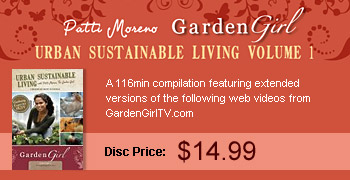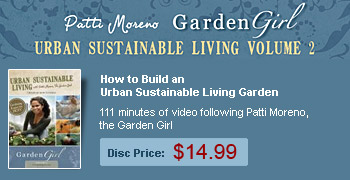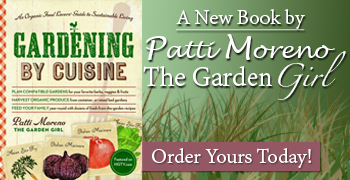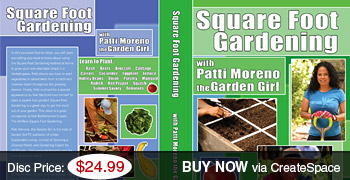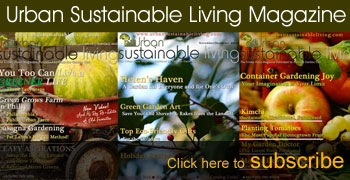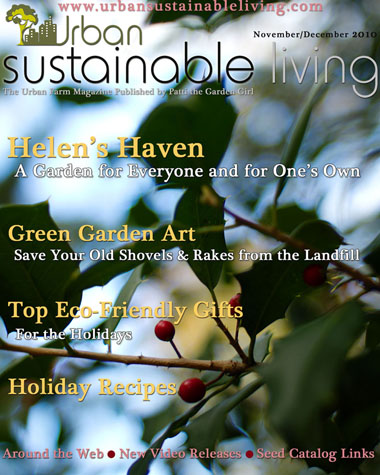Fruit Trees and Berry Bushes
A big part of having an edible landscape is finding plants that can produce fruit successfully outside of the raised bed. My yard is filled with fruit trees and berry bushes that are both beautiful year-round, and delicious when they're ripe! Apples, prunes, plums, cherries, berries - you'll have more fruit than you'll know what to do with. I'll even show you how to use grape vines to decorate your vertical spaces with gorgeous leaves and bountiful fruit.
In this section, I'll share all kinds of tips for planting and maintaining fruit trees and berries throughout your landscape. From designing and spacing to pruning and watering, growing fruit in your yard is very different than growing vegetables in your garden. Plus, fruit trees and berries are a long-term investment that will only get bigger, more beautiful, easier to maintain, and more prolific with each passing year! So take a look, and maybe you'll be inspired to turn your yard into your own private orchard.
Lingonberries in the Edible Landscape
Have you ever heard of lingonberries? Most likely, not. But if you know anything about Sweden or you’ve shopped at IKEA, you’ve at least heard them mentioned. Let me tell you what they are. The lingonberry is a hardy perennial evergreen shrub, closely related to blueberries and cranberries. They can be found in forests in northern Europe, Northern America and Canada. They are a small tasty berry that is a mainstay of Swedish cuisine. In Sweden and other parts of Europe, lingonberries are used in every thing imaginable, including wines, liqueurs, soda, jelly, jam, Swedish pancakes, sauces for with meats and fish dishes and any other time that blueberries or cranberries are used. The unique tartness of lingonberries offer a whole new dimension to traditional dishes.
Read more...Sweet Cherry Trees are a Great Addition to Every Home Garden for Fresh Eating
Here are some of the reasons why I love cherries! 1) Cherries contain antioxidants that help reduce inflammation and pain as well as help fight chronic illnesses such as reducing cholesterol; 2) Cherries make a great snack and 3) Cherry blossoms signal spring!
My new cherry trees have just arrived and in this video you will see how I prepare them to be planted in a container. You will see that these trees look different from the ones that you are used to seeing me work with. These are brand new bare root trees which means they have to be prepared for a container, differently than other already potted plants. Did you even know that it’s possible to plant trees in a container? Let me show you how.
Read more...Tips for Growing Grapes
There are so many uses for grapes. Fresh grapes make a healthy fruit snack eaten by the bunch and it’s a great addition to a fruit salad. You can also make delicious jams and jellies and can them to enjoy all winter.
I’m so excited! They’re finally here! My Sweet Lace Grapes that will grow beautifully in my patio container garden. If you are not familiar with this type of grape, I’ll show you. Sweet Lace grapes are different than the other types of grapes that I grow. The Sweet Lace plants are slightly more delicate with a lacey ruffle in their foliage.
Read more...How to Plant a Tree
I thought it would be nice to learn how to properly plant a tree. So, I asked my friend, arborist, Gary Overton, to help me show you how to plant a tree, the right way. This is something anyone can learn. The best time to plant a tree is the spring or fall. Fall is usually even better than spring because in most places temperatures are moderate and there is plenty of rain.
The only type of tree that I don’t already have in my garden is a Japanese Maple – so today that is what Gary and I are going to plant.
Read more...How to Prune A Tree
This is your lucky day. I am going to give you a 5 minute lesson that will change your life and the life of your trees. I am joined by my friend, Gary Overton, an arborist, who is helping me prune my very large plum tree while teaching us all to prune properly.
Gary explains that the main thing you want to do when pruning a tree is to eliminate the water spouts (some call them “suckers.” These small little sprouts can’t produce fruit. By removing them it allows the trees to deposit their nutrients in places where it will count.
Read more...Growing Blueberries
My mouth is watering thinking about all of the delicious things I can make with blueberries; Pie, Grunt, Jelly, muffins, Pancakes, Smoothies, Bars and cereal...And they’re good for you!
New England (zones 4-7) is the best area for blueberries to thrive. What’s great about these healthful anti-oxidant-rich berry is that they are durable and versatile and can grow in lots of other zones, as well. You can plant blueberries in the spring, but they’re also excellent to plant in the fall. Planting blueberries doesn’t take much work. Find a place to plant your blueberries where they will receive full sun at least 6-8 hours a day. If you are in more of an urban environment they grow well in clay or rocky soil, too!
Read more...Designing Sustainable and Edible Landscapes
Americans think big! And our obsession with all things big has to change for the good of the earth. Large lawns were once meant to symbolize status. Back in the day, large lawns earned their reputation with good reason. Historically, a large “lawn” meant that there were plenty of sheep and cattle grazing on the land. That is usually not the case when driving through any town USA these days. Today’s large lawns only mean one thing: Waste!
Large lawns waste acres of usable real estate, use tons of water and maintaining them create noise and air pollution. Additionally, the pesticides needed to keep grass alive, poisons our soil, sewers, and ground water with harmful pesticides and petro-chemicals.
Read more...Design a City Orchard by Planting Fruit Trees
Ancient Greek proverb: “A society grows great when old men plant trees in whose shade they know they will never sit in.”
The value of trees:
- Trees combat climate change
- Trees clean the air by filtering pollutants
- The percentage of tree canopies have steadily declined in major metropolitan areas since the 1970's
How to Grow Apple Trees
In this video, I am going to take you on a little tour through my city apple orchard.You will see that I have planted Semi Dwarf and Dwarf trees and they are Red Delicious Apples and Cortland Apples.Both of these varieties are excellent for cooking but the Cortland apples are slightly tarter, making them perfect for salads. The most important thing to remember about growing apples is that they take a few years before they fruit. These orchards that we are walking through are the result of work that I did nearly two years ago. So be patient!
Read more...How to Grow a City Vineyard
Welcome to my Grape Arbor Trellis. Here you’ll see me training my grapes to grow upward on the trellis. I am using jute twine which is an organic material that complements the look of my garden. Because it’s natural it will eventually decay – but by the time that happens, my grapes will have already taken hold of my arbor.
As I attach the grapes, I do it loosely because the sun and rain will cause the jute to shrink. By giving the jute ample length in between each attachment, it allows the grapes and the jute to do what they do, without hampering the process.
Read more...

